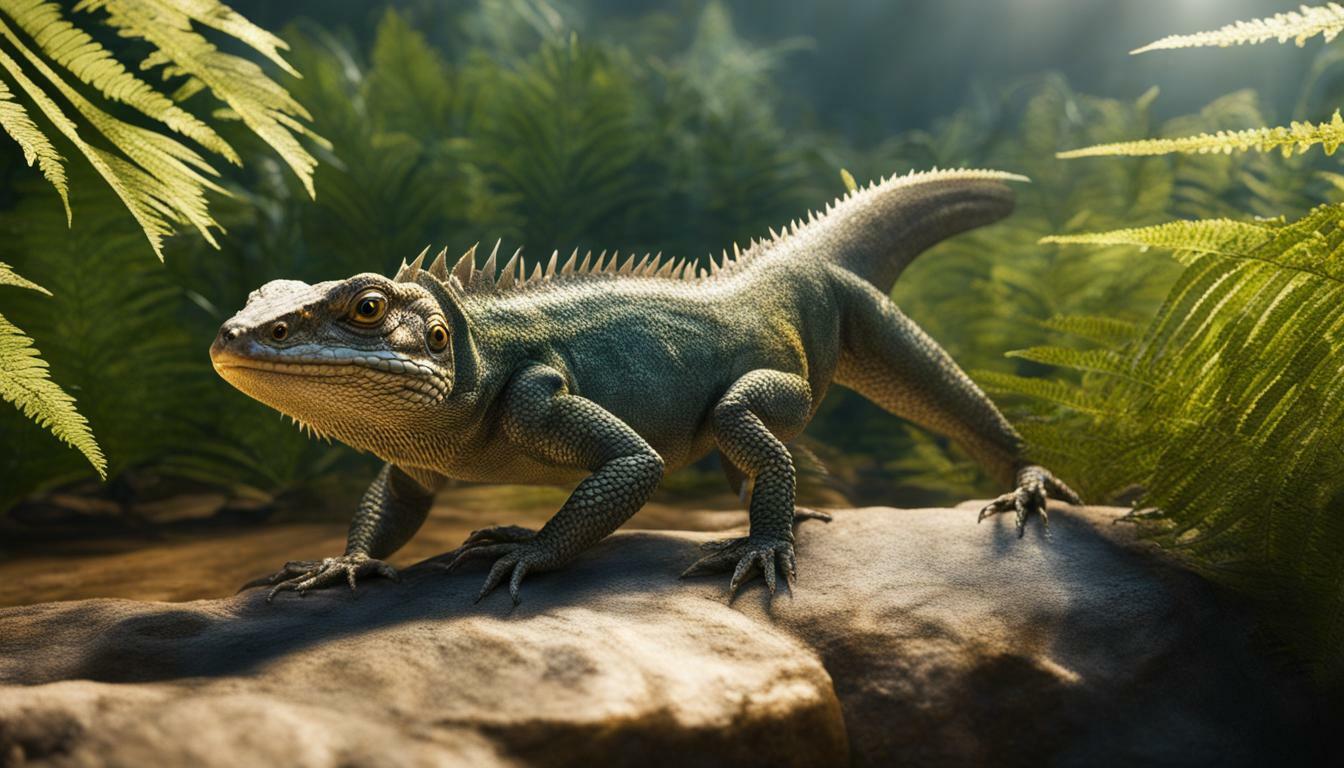The evolution of lizards is a fascinating topic that has been extensively studied through the analysis of fossil records. Understanding the timeline and origins of lizards provides valuable insights into the broader context of reptile evolution and sheds light on the diversity and ecological impacts of these ancient creatures throughout Earth’s history.
Key Takeaways:
- Lizard evolution has been a subject of significant scientific research, primarily through the analysis of fossil records.
- A recent study challenges the theory of adaptive radiation, suggesting that the evolution of reptiles, including lizards, occurred through many small bursts of morphological changes over a period of 50 million years.
- The early evolution of most lizard lineages was found to be a continuous and incremental process, contrary to the belief that major evolutionary events happen in rapid bursts.
- The fossil record provides valuable evidence for understanding the timeline and origins of lizards, revealing key milestones and important evolutionary developments.
- Studying lizard evolution helps us gain insights into the broader context of reptile evolution and the ecological impacts of these ancient creatures.
The Evolutionary Journey of Reptiles
To understand the evolution of lizards, it is essential to explore the evolutionary journey of reptiles as a whole. A recent study conducted by researchers from Harvard University and the University of Alberta challenges the widely held theory that major transitions in reptile evolution happened in quick bursts triggered by significant environmental shifts. The study analyzed a vast database of nearly 1,000 reptilian fossils and found that the evolution of extinct lineages of reptiles took place through many small bursts of morphological changes over a period of 50 million years.
This finding contradicts the theory of adaptive radiation, which suggests that major evolutionary events happen in one rapid burst. Instead, the study reveals that the early evolution of most lizard lineages was a continuous and incremental process. This means that the diversity and ecological impacts of reptiles throughout Earth’s history occurred gradually and steadily, rather than in sudden bursts.
By examining the broader context of reptile evolution, we can gain insights into how lizards fit into the larger picture. The origin of lizards can be traced back to ancient reptiles, which emerged during the Paleozoic Era. These ancient reptiles, such as the archosaurs and synapsids, paved the way for the evolution of various reptilian lineages, including lizards. Throughout the Mesozoic Era, reptiles continued to diversify, with lizards evolving alongside other groups like dinosaurs and crocodiles.
Overall, understanding the evolutionary journey of reptiles provides valuable context for comprehending the evolution of lizards. The recent study’s findings challenge previous assumptions and shed light on the continuous and incremental nature of lizard lineages’ evolution. By unraveling the prehistoric timeline and exploring ancient reptiles, we can gain a deeper appreciation for the rich evolutionary history of these fascinating creatures.
Challenging the Theory of Adaptive Radiation
A recent study has called into question the theory of adaptive radiation in reptile evolution, providing new insights into the evolution of lizards. This study, conducted by researchers from Harvard University and the University of Alberta, analyzed an extensive database of nearly 1,000 reptilian fossils, revealing a different perspective on how reptiles evolved.
Contrary to the widely held theory of adaptive radiation, which suggests that major transitions in reptile evolution occurred in quick bursts triggered by significant environmental shifts, the study found that the evolution of extinct reptile lineages actually took place through many small bursts of morphological changes over a period of 50 million years. This challenges the conventional understanding of how reptiles diversified and adapted to their environments.
The study also shed light on the early evolution of most lizard lineages, revealing that it was a continuous and incremental process. This finding suggests that the diversity and ecological impacts of lizards throughout Earth’s history were not solely driven by sudden bursts of adaptive radiation but rather through gradual changes over time.
| Key Findings: |
|---|
| Reptile evolution did not occur in rapid bursts triggered by environmental shifts, but rather through small bursts of morphological changes. |
| The early evolution of lizard lineages was a continuous and incremental process. |
| The diversity and ecological impacts of lizards were shaped by gradual changes over time. |
Overall, this study provides valuable insights into the evolution of lizards and challenges the long-held theory of adaptive radiation. By analyzing a vast database of reptilian fossils, researchers have discovered that the evolutionary history of reptiles, including lizards, is more complex than previously thought. This new understanding opens up further avenues of research and encourages a reconsideration of how we perceive the evolutionary processes that have shaped life on Earth.
The Continuous and Incremental Evolution of Lizard Lineages
The study’s findings highlight the continuous and incremental nature of lizard evolution, shaping the diversity and ecological roles of these creatures. Contrary to the theory of adaptive radiation, which proposes that major evolutionary events occur in rapid bursts triggered by significant environmental shifts, the research conducted by scientists from Harvard University and the University of Alberta provides evidence that the evolution of extinct reptile lineages, including lizards, took place through many small bursts of morphological changes over a span of 50 million years.
This comprehensive analysis of nearly 1,000 reptilian fossils challenged the prevailing belief that lizard evolution occurred in abrupt shifts caused by ecological disruptions. Instead, the study reveals that lizard lineages underwent a continuous and incremental process of change. This indicates that the evolutionary history of most lizard lineages was shaped by gradual modifications rather than sudden transformations.
These findings shed light on the diversity and ecological impacts of reptiles throughout Earth’s history. The continuous nature of lizard evolution allowed for the development of a wide range of species, each adapted to specific ecological niches. As reptiles, including lizards, played crucial roles in various ecosystems, their continuous and incremental evolution contributed to the intricate web of life on our planet.
| Lizard Evolution Timeline | Years Ago |
|---|---|
| Origin of reptiles | Over 300 million |
| Emergence of ancient reptiles | Over 250 million |
| Evolution of lizard lineages | Between 250 and 200 million |
| Diversification and ecological impacts of lizards | From 200 million onwards |
In conclusion, the study’s findings provide valuable insights into the evolutionary history of lizards. By challenging the theory of adaptive radiation, these findings demonstrate that lizard lineages evolved continuously and incrementally over millions of years, contributing to the remarkable diversity and ecological roles of lizards in various ecosystems. This research enhances our understanding of the complex and gradual processes that have shaped the evolution of reptiles, lizards, and the natural world as a whole.
Unveiling the Prehistoric Timeline of Lizards
By examining the rich fossil record, we can piece together the prehistoric timeline of lizard evolution and gain insights into their ancient origins. Lizards, a diverse group of reptiles, have a fascinating evolutionary history that spans millions of years. Throughout this timeline, we can observe the emergence of various lizard lineages, their adaptations to changing environments, and their contributions to the ecosystem.
The fossil record provides valuable evidence of the early stages of lizard evolution. Ancient reptiles, such as the reptile-like ancestors of lizards known as diapsids, first appeared over 300 million years ago. These early reptiles laid the foundation for the subsequent evolution of various reptilian groups, including lizards.
As we delve deeper into the prehistoric timeline, we encounter significant milestones in lizard evolution. One notable event is the emergence of the first true lizards, which occurred approximately 200 million years ago. These ancient lizards gradually diversified and gave rise to numerous lineages that adapted to different habitats and ecological niches.
| Timeline of Lizard Evolution | |
|---|---|
| Over 300 million years ago | Diapsids, reptile-like ancestors of lizards, appear |
| Approximately 200 million years ago | The first true lizards emerge |
| Various periods throughout history | Lizards diversify and adapt to different environments |
Throughout their evolutionary journey, lizards have become incredibly diverse, occupying a wide range of habitats across the globe. They have evolved various adaptations, such as the ability to regenerate lost tails, to thrive in their respective environments.
In conclusion, the prehistoric timeline of lizard evolution allows us to unravel the ancient origins of these remarkable reptiles. Through the study of fossils, we can trace the emergence and diversification of lizards, gaining valuable insights into their evolutionary processes and ecological impacts over millions of years.
Conclusion
The study of lizard evolution provides a captivating glimpse into the ancient history of these reptiles, and the research conducted challenges previous theories while shedding light on the gradual and complex nature of their evolutionary journey. A recent study by researchers from Harvard University and the University of Alberta analyzed nearly 1,000 reptilian fossils and revealed surprising insights into the evolution of lizards. Contrary to the widely held theory of adaptive radiation, which suggests that major transitions in reptile evolution happen in rapid bursts triggered by environmental shifts, the study found that the evolution of extinct reptilian lineages occurred through many small bursts of morphological changes over a 50 million-year period.
Furthermore, the study also highlighted that the early evolution of most lizard lineages was a continuous and incremental process. This challenges the notion that significant evolutionary events happen all at once, instead showing that they unfold over extended periods. These findings not only provide a new perspective on lizard evolution but also offer insights into the diversity and ecological impacts of reptiles throughout Earth’s history.
By analyzing a vast database of reptilian fossils, this research sheds light on the intricate and fascinating journey of lizard evolution. It highlights the complexity of their lineage and underscores the need to reevaluate long-held theories. Understanding the timeline of lizard evolution is crucial for grasping the ecological dynamics of the past, as well as for informing our understanding of the present and the future.
In conclusion, the study of lizard evolution has unveiled a prehistoric timeline filled with gradual changes and small bursts of morphological innovations. These findings challenge traditional theories and significantly contribute to our understanding of the ancient history of lizards. While there is still much more to learn, these revelations highlight the intricate nature of the evolutionary processes that have shaped the reptilian world.
FAQ
Q: What does the recent study on reptile evolution challenge?
A: The recent study challenges the widely held theory that major transitions in reptile evolution happened in quick bursts triggered by significant environmental shifts.
Q: Who conducted the study on reptile evolution?
A: The study was conducted by researchers from Harvard University and the University of Alberta.
Q: What did the study analyze?
A: The study analyzed a vast database of nearly 1,000 reptilian fossils.
Q: What did the study find regarding the evolution of extinct reptile lineages?
A: The study found that the evolution of extinct lineages of reptiles took place through many small bursts of morphological changes over a period of 50 million years.
Q: What theory does the study contradict?
A: The study contradicts the theory of adaptive radiation, which suggests that major evolutionary events happen in one rapid burst.
Q: What did the study find about the early evolution of most lizard lineages?
A: The study found that the early evolution of most lizard lineages was a continuous and incremental process.
Q: What insights do the findings provide?
A: The findings provide insights into the diversity and ecological impacts of reptiles throughout Earth’s history.
Q: What is the significance of understanding the evolution of lizards?
A: Understanding the evolution of lizards helps us comprehend their origins, adaptability, and ecological role in the natural world.

